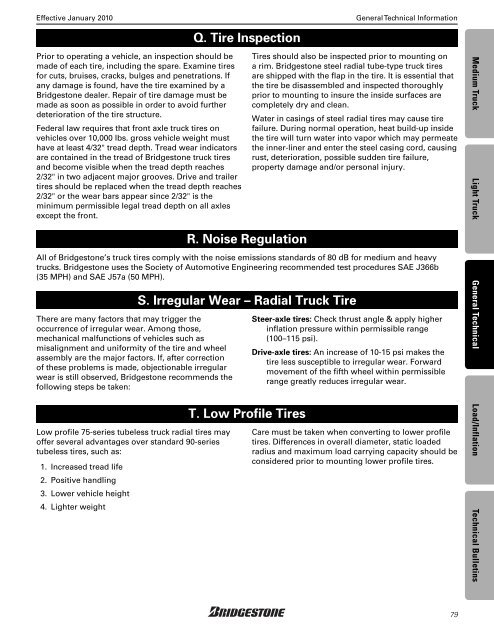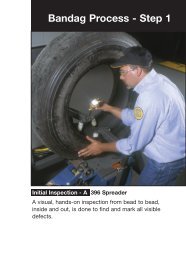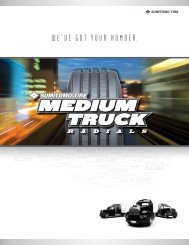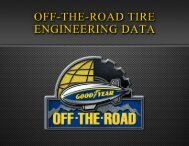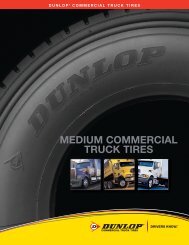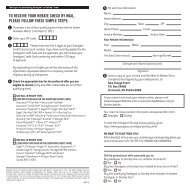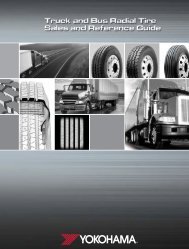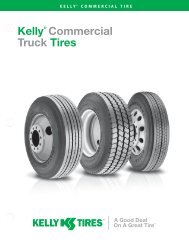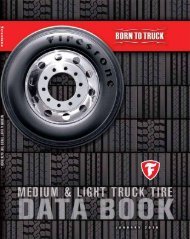Bridgestone Medium and Light Truck Tire Data Book - Sullivan Tire ...
Bridgestone Medium and Light Truck Tire Data Book - Sullivan Tire ...
Bridgestone Medium and Light Truck Tire Data Book - Sullivan Tire ...
You also want an ePaper? Increase the reach of your titles
YUMPU automatically turns print PDFs into web optimized ePapers that Google loves.
Effective January 2010<br />
Prior to operating a vehicle, an inspection should be<br />
made of each tire, including the spare. Examine tires<br />
for cuts, bruises, cracks, bulges <strong>and</strong> penetrations. If<br />
any damage is found, have the tire examined by a<br />
<strong>Bridgestone</strong> dealer. Repair of tire damage must be<br />
made as soon as possible in order to avoid further<br />
deterioration of the tire structure.<br />
Federal law requires that front axle truck tires on<br />
vehicles over 10,000 lbs. gross vehicle weight must<br />
have at least 4/32" tread depth. Tread wear indicators<br />
are contained in the tread of <strong>Bridgestone</strong> truck tires<br />
<strong>and</strong> become visible when the tread depth reaches<br />
2/32" in two adjacent major grooves. Drive <strong>and</strong> trailer<br />
tires should be replaced when the tread depth reaches<br />
2/32" or the wear bars appear since 2/32" is the<br />
minimum permissible legal tread depth on all axles<br />
except the front.<br />
Q. <strong>Tire</strong> Inspection<br />
R. Noise Regulation<br />
General Technical Information<br />
<strong>Tire</strong>s should also be inspected prior to mounting on<br />
a rim. <strong>Bridgestone</strong> steel radial tube-type truck tires<br />
are shipped with the flap in the tire. It is essential that<br />
the tire be disassembled <strong>and</strong> inspected thoroughly<br />
prior to mounting to insure the inside surfaces are<br />
completely dry <strong>and</strong> clean.<br />
Water in casings of steel radial tires may cause tire<br />
failure. During normal operation, heat build-up inside<br />
the tire will turn water into vapor which may permeate<br />
the inner-liner <strong>and</strong> enter the steel casing cord, causing<br />
rust, deterioration, possible sudden tire failure,<br />
property damage <strong>and</strong>/or personal injury.<br />
All of <strong>Bridgestone</strong>’s truck tires comply with the noise emissions st<strong>and</strong>ards of 80 dB for medium <strong>and</strong> heavy<br />
trucks. <strong>Bridgestone</strong> uses the Society of Automotive Engineering recommended test procedures SAE J366b<br />
(35 MPH) <strong>and</strong> SAE J57a (50 MPH).<br />
There are many factors that may trigger the<br />
occurrence of irregular wear. Among those,<br />
mechanical malfunctions of vehicles such as<br />
misalignment <strong>and</strong> uniformity of the tire <strong>and</strong> wheel<br />
assembly are the major factors. If, after correction<br />
of these problems is made, objectionable irregular<br />
wear is still observed, <strong>Bridgestone</strong> recommends the<br />
following steps be taken:<br />
Low profile 75-series tubeless truck radial tires may<br />
offer several advantages over st<strong>and</strong>ard 90-series<br />
tubeless tires, such as:<br />
1. Increased tread life<br />
2. Positive h<strong>and</strong>ling<br />
3. Lower vehicle height<br />
4. <strong>Light</strong>er weight<br />
S. Irregular Wear – Radial <strong>Truck</strong> <strong>Tire</strong><br />
T. Low Profile <strong>Tire</strong>s<br />
Steer-axle tires: Check thrust angle & apply higher<br />
inflation pressure within permissible range<br />
(100–115 psi).<br />
Drive-axle tires: An increase of 10-15 psi makes the<br />
tire less susceptible to irregular wear. Forward<br />
movement of the fifth wheel within permissible<br />
range greatly reduces irregular wear.<br />
Care must be taken when converting to lower profile<br />
tires. Differences in overall diameter, static loaded<br />
radius <strong>and</strong> maximum load carrying capacity should be<br />
considered prior to mounting lower profile tires.<br />
<strong>Medium</strong> <strong>Truck</strong> <strong>Light</strong> <strong>Truck</strong> General Technical Load/Inflation Technical Bulletins<br />
79


